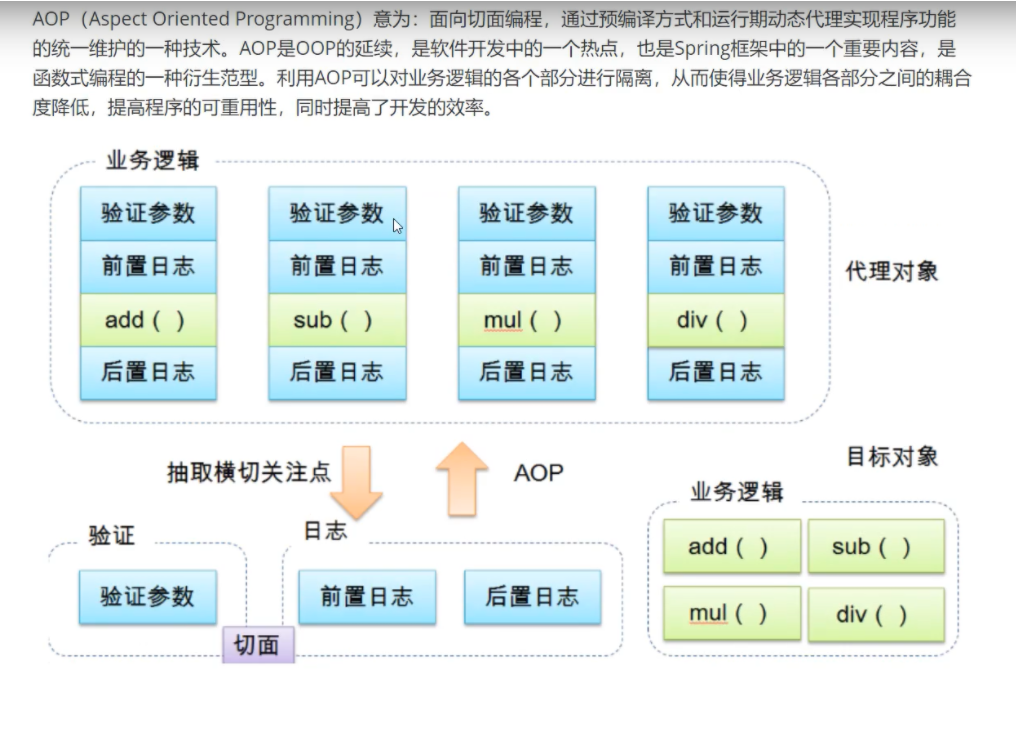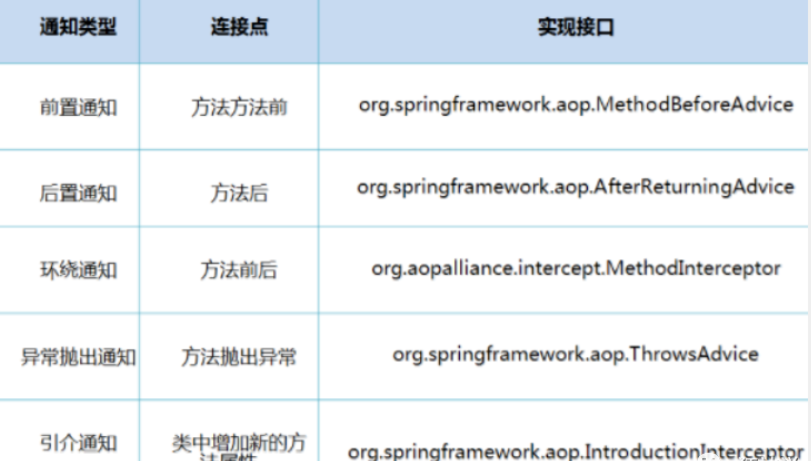AOP(Aspect Oriented Programming),即面向切面编程,可以说是OOP(Object Oriented Programming,面向对象编程)的补充和完善。散布在各处的无关的代码被称为横切(cross cutting),在OOP设计中,它导致了大量代码的重复,而不利于各个模块的重用。 AOP技术恰恰相反,它利用一种称为"横切"的技术,剖解开封装的对象内部,并将那些影响了多个类的公共行为封装到一个可重用模块,并将其命名为"Aspect",即切面。所谓"切面",简单说就是那些与业务无关,却为业务模块所共同调用的逻辑或责任封装起来,便于减少系统的重复代码,降低模块之间的耦合度,并有利于未来的可操作性和可维护性。

提供声明式事务;允许用户自定义切面
以下名词需要了解下:
- 横切关注点:跨越应用程序多个模块的方法或功能。与我们业务逻辑无关的,但是我们需要关注的部分就是横切关注点。如日志,安全,缓存,事务等
- 切面(ASPECT):类是对物体特征的抽象,切面就是对横切关注点的抽象。即,它是一个类
- 通知(Advice):切面必须要完成的工作。即,它是类中的一个方法。
- 目标(Target):被通知对象
- 代理(Proxy):向目标对象应用通知之后创建的对象
- 切入点(PointCut):切面通知 执行的 “地点”的定义
- 连接点(JointPoint):与切入点匹配的执行点。
SpringAOP中,通过Advice定义横切逻辑,Spring中支持5种类型的Advice:

使用Spring实现Aop
导入依赖
<!-- https://mvnrepository.com/artifact/org.aspectj/aspectjweaver --> <dependency> <groupId>org.aspectj</groupId> <artifactId>aspectjweaver</artifactId> <version>1.9.6</version> <scope>runtime</scope> </dependency> <!-- https://mvnrepository.com/artifact/org.aspectj/aspectjrt --> <dependency> <groupId>org.aspectj</groupId> <artifactId>aspectjrt</artifactId> <version>1.9.6</version> </dependency>
第一种方式
通过Spring API实现
首先编写业务接口和实现类
public interface UserService { public void add(); public void delete(); public void update(); public void query(); }
public class UserServiceImpl implements UserService{ public void add() { System.out.println("增加了一个用户"); } public void delete() { System.out.println("删除了一个用户"); } public void update() { System.out.println("更新了一个用户"); } public void query() { System.out.println("查询了一个用户"); } }
然后去写我们的增强类 , 我们编写两个 , 一个前置增强 一个后置增强
public class Log implements MethodBeforeAdvice { //method : 要执行的目标对象的方法 //objects : 被调用的方法的参数 //Object : 目标对象 @Override public void before(Method method, Object[] objects, Object o) throws Throwable { System.out.println( o.getClass().getName() + "的" + method.getName() + "方法被执行了"); } } public class AfterLog implements AfterReturningAdvice { //returnValue 返回值 //method被调用的方法 //args 被调用的方法的对象的参数 //target 被调用的目标对象 @Override public void afterReturning(Object returnValue, Method method, Object[] args, Object target) throws Throwable { System.out.println("执行了" + target.getClass().getName() +"的"+method.getName()+"方法," +"返回值:"+returnValue); } }
最后去spring的文件中注册 , 并实现aop切入实现 , 注意导入约束 .
<?xml version="1.0" encoding="UTF-8"?> <beans xmlns="http://www.springframework.org/schema/beans" xmlns:xsi="http://www.w3.org/2001/XMLSchema-instance" xmlns:aop="http://www.springframework.org/schema/aop" xsi:schemaLocation="http://www.springframework.org/schema/beans http://www.springframework.org/schema/beans/spring-beans.xsd http://www.springframework.org/schema/aop http://www.springframework.org/schema/aop/spring-aop.xsd"> <!--注册bean--> <bean id="userService" class="com.wang.service.UserServiceImpl"/> <bean id="log" class="com.wang.log.Log"/> <bean id="afterLog" class="com.wang.log.AfterLog"/> <!--aop的配置--> <aop:config> <!--切入点 expression:表达式匹配要执行的方法--> <aop:pointcut id="pointcut" expression="execution(* com.wang.service.UserServiceImpl.*(..))"/> <!--执行环绕; advice-ref执行方法 . pointcut-ref切入点--> <aop:advisor advice-ref="log" pointcut-ref="pointcut"/> <aop:advisor advice-ref="afterLog" pointcut-ref="pointcut"/> </aop:config> </beans>
测试
public class MyTest { @Test public void test(){ ApplicationContext context = new ClassPathXmlApplicationContext("beans.xml"); UserService userService = (UserService) context.getBean("userService"); userService.search(); } }
第二种方式
自定义类来实现Aop
目标业务类不变依旧是userServiceImpl
第一步 : 写我们自己的一个切入类
public class DiyPointcut { public void before(){ System.out.println("---------方法执行前---------"); } public void after(){ System.out.println("---------方法执行后---------"); } }
去spring中配置
<!--第二种方式自定义实现--> <!--注册bean--> <bean id="diy" class="com.wang.config.DiyPointcut"/> <!--aop的配置--> <aop:config> <!--第二种方式:使用AOP的标签实现--> <aop:aspect ref="diy"> <aop:pointcut id="diyPonitcut" expression="execution(* com.wang.service.UserServiceImpl.*(..))"/> <aop:before pointcut-ref="diyPonitcut" method="before"/> <aop:after pointcut-ref="diyPonitcut" method="after"/> </aop:aspect> </aop:config>
测试:
public class MyTest { @Test public void test(){ ApplicationContext context = new ClassPathXmlApplicationContext("beans.xml"); UserService userService = (UserService) context.getBean("userService"); userService.add(); } }
第三种方式
使用注解实现
第一步:编写一个注解实现的增强类
package com.wang.config; import org.aspectj.lang.ProceedingJoinPoint; import org.aspectj.lang.annotation.After; import org.aspectj.lang.annotation.Around; import org.aspectj.lang.annotation.Aspect; import org.aspectj.lang.annotation.Before; @Aspect public class AnnotationPointcut { @Before("execution(* com.wang.service.UserServiceImpl.*(..))") public void before(){ System.out.println("---------方法执行前---------"); } @After("execution(* com.wang.service.UserServiceImpl.*(..))") public void after(){ System.out.println("---------方法执行后---------"); } @Around("execution(* com.wang.service.UserServiceImpl.*(..))") public void around(ProceedingJoinPoint jp) throws Throwable { System.out.println("环绕前"); System.out.println("签名:"+jp.getSignature()); //执行目标方法proceed Object proceed = jp.proceed(); System.out.println("环绕后"); System.out.println(proceed); } }
第二步:在Spring配置文件中,注册bean,并增加支持注解的配置
<!--第三种方式:注解实现--> <bean id="annotationPointcut" class="com.kuang.config.AnnotationPointcut"/> <aop:aspectj-autoproxy/>
aop:aspectj-autoproxy:说明
通过aop命名空间的<aop:aspectj-autoproxy />声明自动为spring容器中那些配置@aspectJ切面的bean创建代理,织入切面。当然,spring 在内部依旧采用AnnotationAwareAspectJAutoProxyCreator进行自动代理的创建工作,但具体实现的细节已经被<aop:aspectj-autoproxy />隐藏起来了 <aop:aspectj-autoproxy />有一个proxy-target-class属性,默认为false,表示使用jdk动态代理织入增强,当配为<aop:aspectj-autoproxy poxy-target-class="true"/>时,表示使用CGLib动态代理技术织入增强。不过即使proxy-target-class设置为false,如果目标类没有声明接口,则spring将自动使用CGLib动态代理。